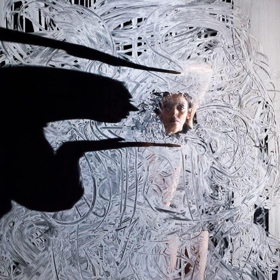Review: NOT TODAY'S YESTERDAY, The Place

![]() Dance has a well-earned reputation for being difficult - lovely to look at, sure, but what does it all mean? Though this collaboration between dancer Seeta Patel (who also wrote the story) and Australian choreographer Lina Limosani is highly abstract in its conception and execution, some words, some props and some exposition make for an accessible, thought-provoking and aesthetically pleasing evening.
Dance has a well-earned reputation for being difficult - lovely to look at, sure, but what does it all mean? Though this collaboration between dancer Seeta Patel (who also wrote the story) and Australian choreographer Lina Limosani is highly abstract in its conception and execution, some words, some props and some exposition make for an accessible, thought-provoking and aesthetically pleasing evening.
Patel is a Bharatanatyam artist, a solo form of Indian classical dance which emphasises gestures - in this performances, particularly fingers and hands - and, to my uninformed eyes at least, has more than a touch of scaled down Bollywood extravaganza in it. As the narrative progresses, the "exotic" otherness falls away and a more familiar dance grammar emerges, the body moving through space, complementing the music, twisting and turning.
And that physical progression mirrors the ethos of the piece - the whitewashing of colonial history. In response to the question, "Who lives? Who dies? Who tells you story?", Not Today's Yesterday inhabits the words (on a scary soundtrack) and culture of the colonialists (and their 21st century apologists) and uses them to demonstrate their redundancy in the face of the people's whose stories have been marginalised, even erased. This "noble savage" has a story of his/her own.
It makes demands on its audience - though at such an event and such a venue, I'm guessing few will buy the "pillaging of a subcontinent in return for railways and an outlawing of suttee" argument, so the irony will not be lost in an age where boneheaded literalism gains ground every day. Much is also made of how transactional politics of today - "What have you done for me lately?" - also sat at the heart of the colonial relationship, "gifts" being offered (often backed by firearms) in return for vast resources, even people.
If the hair motif, at once a sign of individual and collective confidence but also a noose with which a culture could be strangled (or strangle itself) worked well, I was less sure about the white paint running down glass, that turned into a simulacrum of cell bars to imprison Patel - if that was the intention, it felt a little heavy-handed and obvious in a show that foregrounded the subtle over the sledgehammer.
Of course, more than most art forms, dance demands subjective interpretation and someone with a different experience of life, of performance, of history will see more nuanced and less nuanced meanings in the work - but they will see something,
With work such as this, one feels one should give a round of applause some 48 hours later, once the mind has soaked up such overloading of the senses and the full impact of the artistic vision can be seen (or, at least, seen more clearly). Not for everyone, but those you "get it" will really get it - and what other mark of success can one place on such work but that it succeed so completely on its own terms?
Reader Reviews
Videos

